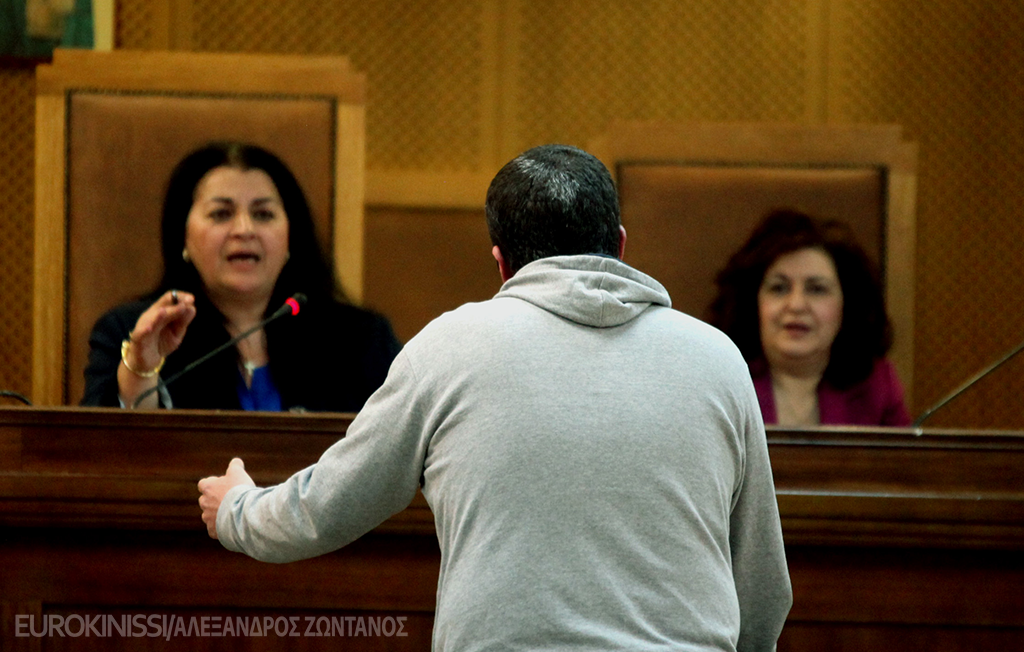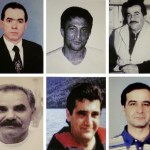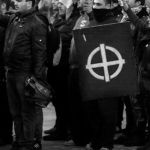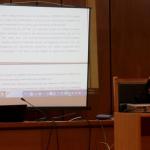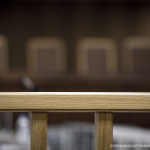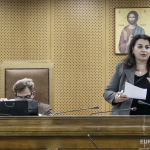42nd Hearing, Women’s Section, Korydallos Prison, Athens 22 December 2015
I. Court access
Hearings remain accessible to members of the public, provided they present their identity cards at the entrance. The size of the crowd in the gallery was the same as in the previous hearing. The spaces reserved for journalists are almost always occupied.
II. Presence and representation of the defendants
Six (6) defendants were present at the beginning of the hearing; thirty-seven (37) were registered as absent. The remaining defendants were represented by their counsel.
III. Evidence of police officer Dimitris Bagios (continued)
The trial continued with the evidence of the 15th witness, police officer Dimitris Bagios, a member of the Dias motorcycle unit.
Continuing his response to questions from presiding judge Maria Lepenioti, Bagios explained that each Dias motorcycle unit has a commander – in his case, Anastasios Tsolakidis. In cases where multiple units are operating in the area, the command is assigned to the most senior officer. That night, Tsolakidis was in command of all units. These positions had been allocated in advance. As the driver of the second motorbike, the witness’s purpose was to observe. When they arrived at the scene, there was no time to reallocate the roles. When Dimitris Hatzistamatis, the alleged go-between, approached the unit, Tsolakidis spoke to him for a couple of minutes. The witness added that Tsolakidis likely took down Hatzistamatis’s details after the incident, during which Hatzistamatis must have remained on the scene. The witness referred the court to Tsolakidis’ testimony for further details.
At the junction of Kefallinias and Tsaldari streets, the witness could not monitor the areas both on his left and right as he was focusing on following his colleague, Andreas Biankis, who was carrying a heavy weapon and could not have defended himself in the event of an attack. There, the witness heard a commotion. When he crossed the median strip, he saw four or five people walking way from 62 Tsaldari St. and officers Angeliki Legatou and Christos Deligiannis restraining Fyssas, who cried out, “Not me!” At that moment, his other colleagues went after Giorgos Roupakias. The four or five people leaving the scene looked just like the other 40 or 50 people in the group: muscular, dressed in black and short-haired. The witness insisted that those people were not among the group of 15 or 20 people his colleagues had chased earlier. He didn’t notice whether they were holding anything.
When he got the scene, Roupakias’ car was already parked there. He didn’t see Roupakias’ movements. He saw his colleagues get Roupakias out of the car. The witness said it didn’t take him long to reach the spot. He was running at the same pace as Biankis, who was slowed down by the weapon he was carrying. The witness tried to call an ambulance, but his colleagues told him they had already called for one. He secured the area and looked for eyewitnesses. Bagios explained that because they were the first unit to reach the scene, they had to secure the area and that it was not their responsibility to make arrests. That was the responsibility of the other units reaching the scene. However, he does not know whether those units proceeded to make any arrests.
When asked by the judge whether he considered the operation a success, the witness responded that they did everything they could, given the information at their disposal. At the time, they did not know that the spot had been the scene of an assault. However, in his view, the operation had been a success given they managed to arrest Roupakias. The witness added that he could not have prevented something he did not know was happening. No one asked him for help. He insisted that, given the situation, they could have done nothing more; they could not have confronted 50 people. The police station had sent them to the scene to observe and to communicate events back to the station; not for them to engage. Their unit is trained to deal with burglary and theft; the MAT riot police is responsible for large gatherings. His unit could have engaged only had they been backed up by more colleagues at the scene. However, the witness did not know whether Tsolakidis, who was the more senior officer and who handled communications with the station, asked for back-up.
At this point, the judge addressed the witness: “Either you made a mistake or the person who gave you a command did.” She asked the witness whether he had discussed the incident and what might have gone wrong with some superior of his; the witness replied that everyone agreed that, given what they knew, they had done the best they could. Indeed, they were lauded by the chief of police. In any case, he continued, no one had asked them to intervene to help. The witness realised that the men gathered on the scene were Golden Dawners; Hatzistamatis had told them as much and the men’s muscularity and short hair confirmed it. The witness stated that he heard about other criminal acts committed by Golden Dawn – such as the attack on the PAME trade unionists and migrant vendors in street markets – through the media. He himself was not involved in dealing with any of these attacks. The witness said he had felt afraid at being faced by a group of 50 people. Moreover, he stated that he did not see anyone in the passenger seat of Roupakias’ car. He did not notice anyone attempt to free Roupakias from the arresting police officers, nor did he see Roupakias try to resist his arrest; Roupakias told the police that he did it because Fyssas had beaten up one of his guys, which led the witness to assume that there had been a fight between Roupakias’ and Fyssas’ group of friends.
Responding to questions from the prosecutor, Adamantia Oikonomou, the witness said that the 50 people assembled on Pavlou Mela St had been a worrying sight. However, he did not see anyone in danger, which is why the police could not proceed to make arrests. They needed to wait for back-up to arrive before they could engage. The people were scattered along the length of Mela St; the witness could not make out a leader. Moreover, the witness did not hear anyone order the 15 people to break away and run towards Tsaldari St. Those people saw someone and they cried out, “come hear, you chickens!” and started running. When the witness reached the spot towards which they were running, Fyssas had already been stabbed. The witness did not see any one of those 15 people have any involvement in Fyssas’ killing; however, they did look just like the people who beat up Fyssas. Roupakias did not look hurt. He was calm and did not resist the police. Police officers Giorgos Rotas and Tsolakidis frisked him. The witness recognized only Roupakias from that night. He didn’t hear his colleague Legatou say, “no, not with knives”.
Responding to questions from the deputy prosecutor, Stelios Kostarellos, the witness explained that he focused on watching Biankis because the latter was carrying a heavy weapon and could not have defended himself if attacked. Here, the judge intervened, saying that the police’s role that night was to protect each other and to arrest Roupakias, who offered no resistance or made any attempt to escape. Responding to a question from a deputy judge, the witness testified that he did not see any men in black driving bikes or any other vehicle. No Dias motorcycle drove to Mela St to scout the area.
IV. Dimitris Bagios’s testimony: cross-examination by the civil counsel
The court then called on the civil counsel to cross-examine Bagios.
Responding to questions from Andreas Tzelis (counsel for the Fyssas family), the witness testified that his passenger had related the content of the police station’s call to him. When the station placed the call, all Dias motorcycle police units in the Attica region received it. Here, the judge interjected; responding to her questions, the witness testified that he didn’t know whether the call was initially addressed to his unit alone, but he was sure that the entire Piraeus force was called to the scene later on. The witness added that he found out after the incident that the call had been placed at 23:59, but didn’t remember who radioed the station to ask for the time.
After they received the call, it took them 2–3 minutes to reach Tsaldari St. He didn’t know the Koralli bar. When they stopped the bikes, the witness got off and scouted the area around Kefallinias and Emmanouil Benaki streets. The witness did not hear Tsolakidis’ communication with the station, even though he was standing only three meters away from him. The witness said that his colleagues Deligiannis and Legatou were the first to run, followed by Rotas and Tsolakidis, and finally by Biankis and the witness himself. The witness said he could not remember whether, in a previous statement, he had testified that he began to run after 30 seconds. If he had, it was a mistake on his part.
Responding to questions from Ellada Christodoulou (also for the Fyssas family), the witness testified that his assignment that night was to observe and to protect his colleagues. He saw the murder weapon on the ground next to the wheel of Roupakias’ car. He could not remember who retrieved it. The witness stated that he was afraid throughout the incident until back-up arrived.
Responding to questions from Violetta Kougiatsou (for Magda Fyssa), the witness testified that when he reached the scene, he saw his colleagues Legatou and Deligiannis pulling Fyssas back while four or five men ran away from the scene. Fyssas was enraged and shouting loudly.
Responding to questions from Chrysa Papadopoulou (for Irini Fyssa), the witness testified that the Dias police are not trained to intervene in or prevent any one specific crime listed in the criminal code, but rather to prevent theft, burglary and robbery in general. When asked what qualifies as a “high-risk patrol”, the witness offered as an example the patrol of a jeep with tinted windows, adding that a gathering of 50 people carrying bats did not count as high risk. The witness added that he saw four or five of the men assembled there carrying helmets. The witness did not, himself, see the bats. He knew the men were Golden Dawners. He added that had the gathering been made up of members of the Ecologists Greens party carrying bats, he would still have been afraid. The witness said he could not remember who handcuffed Roupakias.
Responding to questions from Eleftheria Tompatzoglou (for the Fyssas family), the witness testified that he did not hear all of Tsolakidis’ communication with the police station. As a Special Guard [a unit within the police], he received four months of training, supplemented with further training when he joined the Dias motorcycle police. The witness explained that it was not unusual for the more experienced member of a unit to take responsibility for communications with the station. The group of four to five people ran towards Grigoriou Lambraki St. When asked whether the police would have intervened had those four or five people been mugging Fyssas, the witness replied that he could not know. Either way, he reminded them that the important thing was that they arrested the perpetrator.
Responding to questions from Takis Zotos (for the Egyptian fishermen), the witness testified that he was afraid because he saw 50 people carrying helmets heading in the direction of Koralli bar. The call they received from the station was correct, but incomplete, given it did not mention who had called in with the information. When they reached Mela St and saw the gathering, they realised the men were Golden Dawners and that they had bad intentions.
As regards the assault on the PAME members, the witness knew that Golden Dawners had attacked a number of trade unionists, leaving a few of them injured. He didn’t remember when he found out about it, but it was shortly before Fyssas was murdered. The witness explained that he would have felt equally afraid had he not known about the attacks on the PAME trade unionists, given he knew Golden Dawn to be dangerous. He added that he would not have intervened against 50 people without back-up, regardless of who they were. The witness said he could distinguish a military weapon from a rifle and that he often deals with handguns and Kalashnikovs. When the counsel showed him photographs of Golden Dawn members holding weapons, the defence objected, insisting that he clarify whether the weapons depicted were real or replicas.
At this point, the presiding judge called a half-hour break.
When the hearing resumed, defence counsel Antonis Mammis (for Nikolaos Tsorvas) took the floor and requested that displays of such photographs be accompanied by clarifications of whether the guns depicted were real or replicas, given the latter circulate freely on the market.
The judge responded that the civil counsel had procured a number of photographs and that the defence was at liberty to question the witness on the matter in turn.
The witness continued, replying that the photographs depict a man holding a Kalashnikov, adding that he could not tell from the photograph whether it was a real gun or a replica. Defence counsel Dimitra Velentza intervened and requested the court to disregard the photographs, given they were taken from a defendant’s hard drive without a warrant. Papadakis asked whether the trial was to be censored, describing Velentza’s attitude as unethical and inappropriate.
When shown further photographs, the witness identified a Kalashnikov, Golden Dawn flags and the phrase “Neda river” [where Golden Dawn held nationalist training camps]. These photographs, taken from hard drives belonging to Giorgos Patelis, Giorgos Roupakias and Ioannis Kazantzoglou are included in the case file and were shown to the witness in the same format in which they appear in the case file. The witness said that, if real, the weapons depicted did not circulate freely on the market. He explained that airsoft guns operate either on batteries or with compressed gas. The witness said that Roupakias did not look like the rest of them, who were muscular and short-haired, and yet it was clear that he was linked to them.
Responding to questions from civil counsel Thanasis Kampagiannis (for the Egyptian fishermen), the witness stated that the call “408 Keratsini, come in” was addressed to his unit. His colleagues Tsolakidis and Biankis both had walkie-talkies. Biankis called for an ambulance on his mobile phone, while Tsolakidis called for one on the walkie-talkie. The witness said he didn’t know whether the clock at the police station was set to official Greek time or if there was some lapse between them. After persistent questioning from the counsel, the witness said that if he were to choose between determining the time through a private or public entity he would choose the latter. The witness said that Legatou had not mentioned Fyssas’ girlfriend telling her that her friends had been beaten up. He and his colleagues identified the gathering as an assembly of Golden Dawners. The witness did not remember who retrieved the knife, which lay on the ground for two or three minutes.
Responding to questions from Kostas Papadakis (for the Egyptian fishermen), the witness testified that he did not mean to disassociate Roupakias from the rest; he said only that Roupakias did not look like the rest of them, who were muscular, dressed in black and short-haired. The witness was afraid because the station had told them that there were 50 people holding bats. He stated that Dias units have neither the training nor the weaponry to deal with such situations.
Responding to questions from Angelos Vrettos (for the PAME trade unionists), the witness testified that the Dias unit never formally informed him about the attack on the PAME trade unionists. He knew nothing very specific about the incident, just as he didn’t know whether Golden Dawn ever condemned the attack. The witness said that he could probably recognise a few Golden Dawn MPs.
Here, defense counsel Dimitris Papadellis (for Ilias Kasidiaris) raised an objection to Vrettos’ questions on the grounds that these did not strictly refer to the assault on the PAME members. Civil counsel Papadakis replied that Papadellis did not represent anyone charged with involvement in the Fyssas case.
At this point, the court adjourned until 13 January 2016, instead of 7 January as had originally been scheduled, due to the court clerk having another engagement.
V. Comments on the proceedings and on the atmosphere in the courtroom
The evidence of witness Dimitris Bagios developed along similar lines as that of police officer Angeliki Legatou. The question from the civil counsel regarding who handcuffed and arrested Roupakias and who recovered the knife remain unanswered. Despite persistent questioning from the judges’ bench and the civil counsel, the witness insisted that he and his colleagues could have done nothing to prevent Fyssas’ murder and that they did everything they could. On several occasions, the presiding judge expressed her surprise and indignation at the police’s actions that night.

